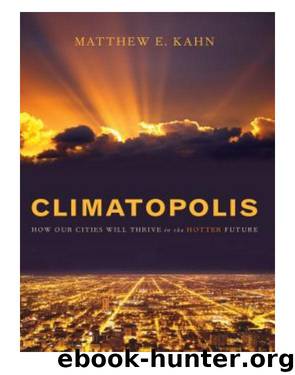Climatopolis by Matthew E. Kahn

Author:Matthew E. Kahn
Language: eng
Format: epub
Publisher: Basic Books
Published: 2010-08-10T16:00:00+00:00
A Green City Future?
Chinese cities rank among the most polluted places in the world.10 China is the largest source of SO2 emissions in the world today, and the damage to health caused by air pollution cost China 3.8 percent of its GDP in 2007.11 In 2006 Beijing’s ambient air pollution (as measured by small particulate matter, PM10) was roughly four times higher than that in Los Angeles. But although China’s local air pollution levels are high, they have declined in many cities recently.
In the United States over the last one hundred years, we have seen the transition of U.S. cities (think of New York City or Pittsburgh) from dirty producers to tourist-friendly green cities. Major cities in China may now be entering a similar transition.
Chinese demand for living in green cities will almost certainly rise as households become better educated and wealthier. Just as in other countries around the world, the footloose, skilled middle class will increasingly demand such amenities. In recent years China’s universities have been graduating millions of students each year. What economists call “human capital”—the knowledge and skills of the population—is the most valuable asset a nation has. By enhancing local environmental quality in its major cities, China would protect the health of this precious asset. Education, wealth, and environmentalism go hand in hand. The better educated the population is, the more wealth it tends to generate, and the more it wants to live in green cities. More educated people are more likely to be environmentalists and thus favor adopting policies for protecting the environment.
In China’s cities, households are revealing a taste for a clean environment. In my own research, I have compared the pricing of comparable apartment units (in Beijing no one lives in a single-family home) in clean and dirty parts of the city.12 I have also made a similar comparison with other Chinese cities.13 Both within Beijing and in other major cities, home prices are lower in communities and cities with higher ambient air pollution levels. Based on the U.S. experience, I predict that Chinese urbanites’ willingness to pay for environmental protection will rise as the nation becomes richer.
Throughout the developed world, wealthier people have demanded more environmental protection as their nations have become richer. The U.S. Environmental Protection Agency (EPA) was founded in 1972—a surprisingly late birth date. The EPA’s Clean Air Act has played an important role in reducing pollution in major U.S. cities. Regulation of new capital, ranging from new cars, to power plants, to industry has contributed to a significant improvement in public health due to decline in pollution. These gains have not been a free lunch. Some have claimed that regulation is a key reason for the U.S. economy’s productivity slowdown in the 1970s. I don’t believe this claim, but it is likely that American consumers have paid higher prices for final consumer products that embody regulated products such as electricity generated at coal-fired power plants and cars that have high-quality catalytic converters. Still, there has been little backlash against the Clean Air Act.
Download
This site does not store any files on its server. We only index and link to content provided by other sites. Please contact the content providers to delete copyright contents if any and email us, we'll remove relevant links or contents immediately.
International Integration of the Brazilian Economy by Elias C. Grivoyannis(57455)
The Radium Girls by Kate Moore(10940)
Turbulence by E. J. Noyes(7081)
Nudge - Improving Decisions about Health, Wealth, and Happiness by Thaler Sunstein(6657)
The Black Swan by Nassim Nicholas Taleb(6230)
Pioneering Portfolio Management by David F. Swensen(5629)
Rich Dad Poor Dad by Robert T. Kiyosaki(5185)
Zero to One by Peter Thiel(4860)
Man-made Catastrophes and Risk Information Concealment by Dmitry Chernov & Didier Sornette(4776)
Secrecy World by Jake Bernstein(3801)
Millionaire: The Philanderer, Gambler, and Duelist Who Invented Modern Finance by Janet Gleeson(3591)
Skin in the Game by Nassim Nicholas Taleb(3496)
The Age of Surveillance Capitalism by Shoshana Zuboff(3445)
The Money Culture by Michael Lewis(3305)
Skin in the Game: Hidden Asymmetries in Daily Life by Nassim Nicholas Taleb(3285)
Bullshit Jobs by David Graeber(3200)
The Dhandho Investor by Mohnish Pabrai(3186)
The Wisdom of Finance by Mihir Desai(3105)
Blockchain Basics by Daniel Drescher(2907)
